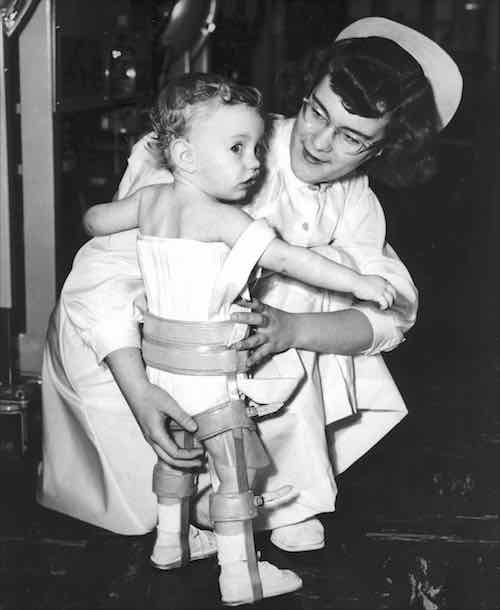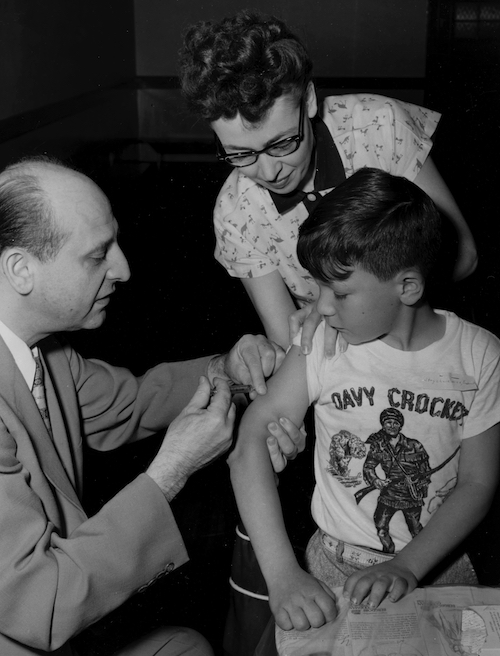Communiqué
AMERICAN EXPERIENCE “The Polio Crusade” To Have Encore Broadcast Tuesday, March 31 at 9 pm
< < Back to american-experience-the-polio-crusade-to-have-encore-broadcast-tuesday-march-31-at-9-pmAmerican Experience The Polio Crusade To Have Encore Broadcast Tuesday, March 31, 2020
A Deadly Virus Is Defeated by a Tireless Crusader, a Scientific Researcher and Dimes from Millions of Americans
The Polio Crusade, produced, directed and written by Sarah Colt, pays tribute to an earlier time when fears of a virus gripped the nation, and Americans banded together to conquer a terrible disease. The film interweaves the personal accounts of polio survivors with the story of an ardent crusader who tirelessly fought on their behalf while scientists raced to find a medical breakthrough. Based in part on David Oshinsky’s Pulitzer Prize-winning book Polio: An American Story, the film features an interview with Julius Youngner, the only surviving scientist from the core research team that developed the Salk vaccine. The Polio Crusade will have an encore broadcast on American Experience Tuesday, March 31, 2020, 9:00-10:00 p.m. on PBS, PBS.org and the PBS Video App.

In the summer of 1950 fear swept through the town of Wytheville, Virginia. Movie theaters shut down, baseball games were cancelled and panicky parents kept their children indoors. Outsiders sped through town with their windows rolled up and bandanas covered their faces. The ones who couldn’t escape the disease were left paralyzed, and some died in the wake of the devastating and contagious virus. Polio had struck in Wytheville. The town was in the midst of a full-blown epidemic. That year alone, more than 33,000 Americans fell victim — half of them under the age of ten.
Anne Crockett-Stark, just seven years old when her brother fell ill during Wytheville’s polio epidemic, recalls: “Daddy and Mama took everything Sonny owned, all of his clothes, his bed, his chest of drawers, and he had a fabulous comic book collection. They took everything out to the middle of the garden and they made a pile and burned everything he owned. They were told to do that, so we would not get it.”
Decades before, polio victims found an unlikely champion in New York lawyer Basil O’Connor, who, in 1928, inherited the leadership of a polio rehabilitation center from his law partner, future president Franklin Delano Roosevelt. As the nation reeled from the economic trauma of the Great Depression, O’Connor faced a pressing challenge: funding. Rather than relying on wealthy philanthropists, O’Connor asked the public to contribute whatever they could. Within days, envelopes stuffed with change flooded the White House mailroom. “The March of Dimes” was born.
O’Connor invested in scientific research to create a vaccine that would end the disease and was impressed with one young researcher, whose sense of urgency matched his own: Dr. Jonas Salk, the director of the Virus Research program at the University of Pittsburgh.

Salk, who had been part of a government effort to develop an influenza vaccine during World War II, believed he could apply the same technique — using killed virus — to polio. But established researchers scoffed at Salk’s theory and dismissed his methods. A bitter feud arose between Salk and his leading rival Albert Sabin, an established polio researcher at the University of Cincinnati who was working on a live virus vaccine.
The two men were unrelenting in their quest, but it was Salk who would introduce his formula first. On April 26, 1954, the Salk vaccine field trials began, the largest public health experiment in American history. No one was certain it was safe or whether it could provide effective protection against the crippling disease. By June 1954, nearly two million school children in 44 states had taken part.
On April 12, 1955, almost a year after the field trials ended, the Salk vaccine was ruled “safe, effective, and potent.” Within just a few years of being licensed, the Salk vaccine decreased the number of polio cases in the United States by 50 percent. By the early 1960s, the number of Americans contracting polio fell to a few thousand annually.
“This vaccine vindicated 20 years of giving dimes, 20 years of volunteering. It was a victory for millions of faceless people who had done what they could to end the scourge of polio,” says David Oshinsky in the film.
“The story of the polio crusade reminds us that Americans can come together to overcome a terrible disease,” says Susan Bellows, American Experience executive producer. “The result was a medical breakthrough that saved countless lives and had a pervasive impact on American philanthropy that continues to be felt today.”
About the Filmmakers
| Producer, Director, Writer
Based in part on the book |
SARAH COLT
POLIO: AN AMERICAN STORY BY DAVID OSHINKY |
| Associate Producer | STEPHANIE MILLS |
| Editor | RANDALL MACLOWRY |
| Music
Senior Consultant Narrator |
JOHN KUSIAK
DAVID OSHINSKY LINDA HUNT |
American Experience is a production of WGBH Boston
| Executive Producers | MARK SAMELS
SUSAN BELLOWS |

